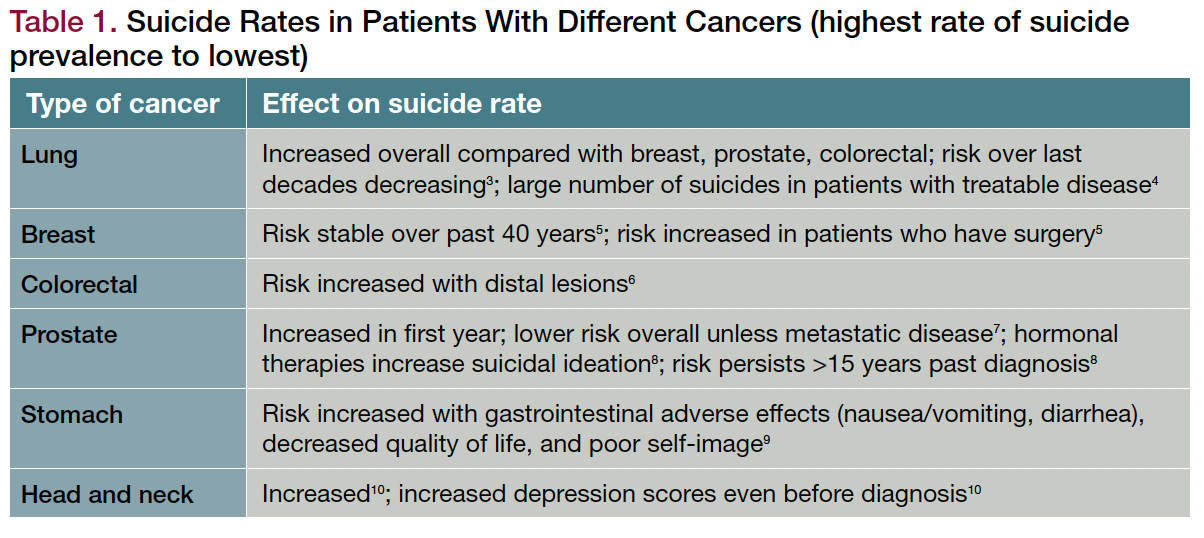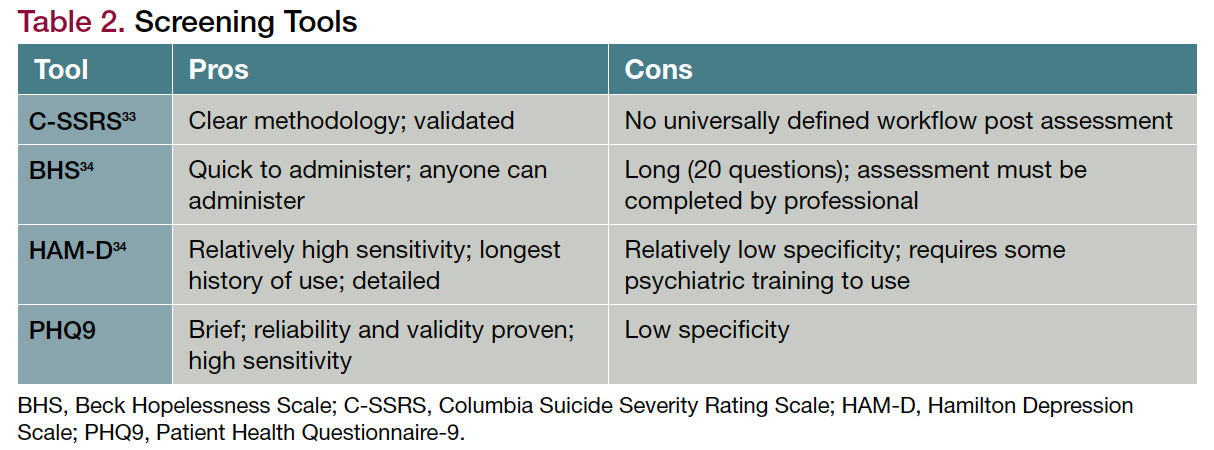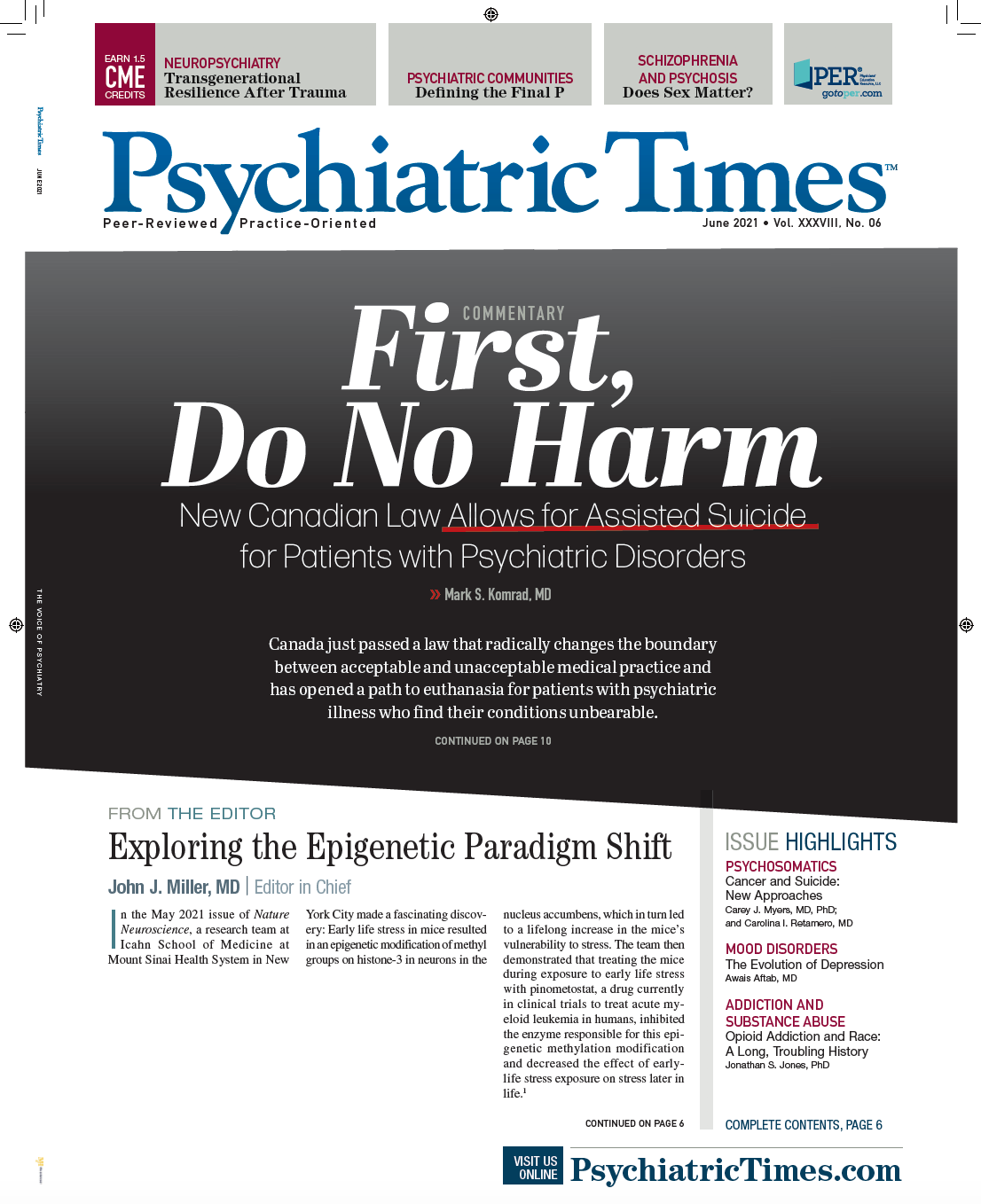Publication
Article
Psychiatric Times
New Approaches and Considerations to Cancer and Suicide
Author(s):
Although estimates vary, patients with cancer are at least twice as likely to die by suicide than people who do not have cancer. By identifying those at greatest risk, these treatment modalities can help support patients.
Photographee.eu/AdobeStock

Suicide and cancer are among the top 10 causes of death in the adult population of the United States. Although the overall prevalence of mortality due to cancer has been decreasing, it is still the second leading cause of US deaths, responsible for 21.3% of total deaths in 2017.1 In comparison, suicide ranks 10th in this list, with 1.7% of total deaths.
Cancer and suicide have both plagued humanity since the beginning of recorded history. The first recorded mention of cancer appears in the Edwin Smith papyrus, dating from about 3000 BCE. Surviving documents from ancient Greek and Roman physicians detail attempts at diagnosing and curing the disease and give us the language we use today (oncology, from the Greek oncos, and cancer, from the Latin cancer, respectively). Suicide, too, has been a factor in death for millennia. The desire to control, to some extent, the timing and manner of one’s death has always been a human temptation, and this draw increases when physical or emotional distress are present.
Although estimates vary, patients with cancer (PWC) are at least twice as likely to die by suicide than people who do not have cancer. Moreover, having had psychiatric care prior to one’s diagnosis of cancer may not mitigate this increased risk.
Suicide Risk in Cancer
The most common cancers worldwide are lung, breast, colorectal, prostate, skin, and stomach; lung, colorectal, stomach, liver, and breast cancers account for the most deaths.2 Suicide risk is not the same for all types of cancer, nor is it consistent over the disease course (Table 1).3-10 Several studies have found that suicide risk is highest immediately after diagnosis.11 Prostate cancer has a higher suicide rate in the first year after diagnosis, but it is associated with a lower overall rate unless metastatic disease is found, with additional increased risk when treatment is defined but not received. Unique to cancer is that the enhanced risk of suicide persists more than 15 years past diagnosis.7
Table 1. Suicide Rates in Patients With Different Cancers (highest rate of suicide
prevalence to lowest)

In addition to increased suicide risk, patients with head and neck cancers have higher depression scores than the general population, even before a cancer diagnosis. Therefore, the question arises of whether this subset of patients struggles with a biological cause in addition to diagnosis-related symptoms.10 Complicating these cases is the well-known association of many head and neck cancers with the use of tobacco, alcohol, and other substances, leading to the question of whether the preexisting mood disorders lead to substance use that increases the risk of cancer. However, the relative increase in number of cases of head and neck cancers linked to human papillomavirus instead of substance use may alter this picture.
In the case of lung cancer, the risk of suicide has been decreasing, but Rahouma and colleagues12 found that these patients are at a higher risk than those with breast, prostate, or colorectal cancer. Furthermore, a large proportion of suicides may occur in patients with possibly nonfatal disease.4
The suicide risk in patients with breast cancer has been relatively stable over the last 4 decades and may be linked to whether the patient has undergone surgery. Findings from Simpson and colleagues13 indicate that penile cancer patients have one of the lowest suicide rates and, in their study, all patients who died by suicide had undergone surgical intervention. The link between surgical intervention and suicide risk may be linked to cosmetic effects, particularly when they affect sexual organs and can potentially alter patients’ view of their desirability and sexual roles.
In colorectal cancer, risk differs depending on the site of the lesion. Distally located disease is linked to a higher rate of suicide. This effect may be due to the more severe effects of distal disease on quality of life. Suicide risk in patients with stomach cancer was independently correlated with diarrhea, which can have a significant impact on lifestyle.9 It is not surprising that patients with terminal cancers report significantly more suicidal ideation.
Screening and Risk Assessment
Very little information has been collected regarding formal suicide risk assessment in PWC (Table 2).14,15 Granek and colleagues16 found that health care providers did not feel adequately prepared to ask about suicidality or to provide support and resources to patients.
Table 2. Screening Tools

The Columbia Suicide Severity Rating Scale is widely used for assessing suicidal intent, acts of furtherance, and suicide attempts. It is available at no cost and is designed to be used by anyone, including individuals without prior mental health care experience; there are versions specifically for individuals with cognitive impairments and for children. However, it does not provide guidance regarding full assessments or further steps if a screening is positive.
The Beck Hopelessness Scale asks true/false questions about future orientation, motivation, and expectations in order to assess negative feelings about the future. It can be used as an indirect evaluation of suicidal thoughts, but it does not address suicidal ideation directly. The detailed interpretation report can be very useful in assessing changes over time. Again, although the questions can be asked by anyone, the interpretation requires a trained professional.
The Hamilton Depression Scale (HAM-D) is a relatively brief questionnaire that asks about a variety of symptoms of depression. Suicide is mentioned in 1 of the 17 questions, which are on a graded scale. It does not ask about atypical symptoms and, while it has relatively high sensitivity, specificity is low.
The Patient Health Questionnaire-9 is a brief set of questions designed to be asked and reviewed by any health care professional, with recommendations of when to advise further assessment by a mental health professional. It has been shown to be reliable and valid in multiple studies. Like the HAM-D, it has relatively high sensitivity and low specificity.
Exploring Risk Factors
Multiple studies have shown cancer as an independent risk factor for completed and attempted suicide. Spoletini and colleagues17 contrasted suicide in the general population, which they attributed to “genetic and psychological vulnerability to stress,” to suicide in PWC, which involved the “intrinsic bio-psychological vulnerability to distress” linked to changes in the immune system associated with cancer. Thus far, research has not identified consistent risk factors that make the vault from suicidal ideation to suicide attempt more likely. Underlying factors such as mood disorders may increase risk but require “additional precipitating events or conditions.”
Depression is a major risk factor, as it is in the general population, but the population with cancer is at higher baseline risk for depression, which has been linked to immunological changes.18 Identification and treatment of depression in PWC has been shown to decrease morbidity and mortality.19
An important component of identifying at-risk patients is to determine the characteristics of those who historically have higher rates of suicide (Table 3).3,20 Physical illnesses in general, particularly those associated with physical pain with consequent lifestyle limitations, are consistent risk factors that play a role in at least 25% of suicides, and the correlation increases with age.21 Patients with significant uncontrolled pain are at higher risk—thus a key component of cancer treatment must be adequate pain control. Minimal information has been collected on how substance use as reaction to a cancer diagnosis contributes to the risk of suicide.
Table 3. Factors Associated With Increased Suicide Risk in Cancer29

Although few thorough examinations of the methods typically used for suicide have been conducted, the National Cancer Institute reports that overdose with painkillers and sedatives is the most common method of suicide used by PWC, and most of these occur at home.22 Despite this, screening for other methods of suicide (particularly firearms) should not be neglected.
Biological Risk Factors
A general understanding of suicidal ideation and behaviors involves alterations in the serotonin and hypothalamic-pituitary-adrenal axis (HPA) systems. Diseases like cancer that alter immune system function can also alter these axes, which may result in increased risk of suicide. Independently of co-occurring cancer, the immune system is altered in depression (eg, changes in cytokine and cell-mediated immunity; changes in HPA axis) and may contribute to the development of depression in a reciprocal manner.
Depression secondary to medical causes should be ruled out in PWC. This typically includes an evaluation of B12 and folate levels and checking for the presence of anemia, thyroid hormone imbalance, or adrenal hormone imbalance. The utility of assessing abnormalities in levels of electrolytes, including sodium, potassium, and magnesium, remains unclear, although there is considerable interest in the effect of imbalances on mental health.
To further complicate this picture, several medications used to treat cancer have been linked to depression, such as corticosteroids, L-asparaginase, interferon-α, and amphotericin B.23-26 Careful review of medication regimens and treatment alternatives may offer options for minimizing the effect of cancer therapy on mental health.
Psychological Risk Factors
The escape model of suicidal drive may play a role, particularly in patients with a terminal diagnosis. This model postulates that the desire to escape from intolerable distress, combined with increased awareness of the factors contributing to that distress, leads to suicide.27 Accordingly, cancers associated with rates of survival of less than 5 years have correlated with higher suicide risk, leading some to wonder whether the type of cancer is more important than the cancer diagnosis.
There are confusing data regarding the complicated mix of desire to speed up death, depression, hopelessness, and suicide risk. It appears that patients with baseline depression are more likely to want hastened death, expressing this desire up to 4 times as often, but Porta-Sales and colleagues28 found that simply discussing the wish for more rapid death did not cause distress, and that nearly 80% of patients felt it was an important topic for the care team to discuss.
Survivors of Childhood Cancers
Studies of suicidal ideation and completed suicide in adult PWC and survivors make up the bulk of the research in this area. As treatments and survival rates for childhood cancers improve, long-term studies of this population must include this information to more fully understand the lifelong effects of cancer treatment in children and adolescents, particularly since suicide is the top cause of death in the young adult populations of many developed countries. Gunnes and colleagues29 showed an increased risk of suicide in Norwegian patients aged 23 to 48 years who had a diagnosis of cancer before age 25 years. At exceptional risk were survivors of brain and testicular tumors, as well as of leukemia. An American study did not replicate this finding but reported an increased risk of suicidal ideation compared with sibling controls.30 The average age of those who reported a first incident of suicidal ideation was 34 years, and they were, on average, 26 years past diagnosis. This is a serious example of how the sequelae of childhood cancer treatment can persist far into adulthood.
Refusal of Treatment
Complicating the discussion of suicide in PWC is the subject of refusal of treatment—should this be considered suicide? Frenkel31 noted that “the unique patients who refuse conventional treatment are at times self-directed, confident, and active, and have thought deeply about the meaning of life and cancer and about their cancer treatment options.” What does it mean to have the ability to choose, to some extent, when we will die? This controversy has been taken all the way to the Supreme Court, with Justice Louis Brandeis writing in Olmstead vs US that “the right to be left alone . . .is the most comprehensive of rights and the right most valued by civilized men,” and Justice Burger clarifying that “nothing in this utterance suggests that Justice Brandeis thought an individual possessed their rights only as to sensible beliefs, valid thoughts, reasonable emotions.”32 Physicians are trained that the ultimate goal is to save or at least prolong life, but often neglected is the consideration of quality of life and patients’ desire to live, and die, in a manner they can, to some extent, control. Isenberg-Grzeda and colleagues33 reported on 3 patients who attempted suicide after being deemed ineligible for medical assistance in dying, further exemplifying the desire to have some say over the end of their lives.
Treatment Options
Treatment for depression in PWC can be quite similar to the treatment of depression in the general population, with psychotherapy and pharmacotherapy (ie, selective serotonin reuptake inhibitors, selective serotonin-norepinephrine reuptake inhibitors, mirtazapine, trazodone) at its core. The most recent review of antidepressant therapy for depression in PWC did not show a significant improvement from placebo, but Ostuzzi and colleagues34 noted that there were few studies from which to draw this information and that much more research is needed.
Psychotherapy, no matter how brief, can help patients adjust to their new health circumstances and to reassess their view of their life up until their diagnosis and their goals going forward. In addition, special considerations, such as the influence of altered immune activity and the effects of chemotherapy, must also weigh into treatment decisions. Moreover, prescribers must be judicious in choosing medications that can be expected to show some positive effect within the patient’s expected lifetime, which may be significantly shortened. Stimulants may be useful in treating the fatigue and inattention that are common during cancer treatment. Close collaboration with the oncologic team can help to optimize mental health during cancer treatment.
Conclusions
Patients with cancer are at increased risk for both suicidal ideation and completed suicide. Factors contributing to this increase are biological and psychological, and both components must be addressed in a timely fashion to increase quality of life. A refusal of treatment must not automatically be considered an instrument of suicide, but should be viewed as a complex decision, factoring in goals of care, particularly quality of life.
Dr Myers is a fourth-year resident and Dr Retamero is a faculty member of the Department of Psychiatry, Albert Einstein Medical Center, Philadelphia, PA. The authors have nothing to disclose regarding this article.
References
1. CDC National Health Report highlights. CDC. Accessed July 14, 2020. https://www.cdc.gov/healthreport/publications/compendium.pdf
2. Cancer. World Health Organization. Updated March 3, 2021. Accessed July 14, 2020. https://www.who.int/news-room/fact-sheets/detail/cancer
3. Zaorsky NG, Zhang Y, Tuanquin L, et al. Suicide among cancer patients. Nature Comm. 2019;10(1):207.
4. Urban D, Rao A, Bressel M, et al. Suicide in lung cancer: who is at risk? Chest. 2013;144(4):1245-1252.
5. Al-Ghazal SK, Fallowfield L, Blamey RW. Comparison of psychological aspects and patient satisfaction following breast conserving surgery, simple mastectomy and breast reconstruction. Eur J Cancer. 2000;36(15):1938-1943.
6. Pham TT, Talukder AM, Walsh NJ, et al. Clinical and epidemiological factors associated with suicide in colorectal cancer. Support Care Cancer. 2019;27(2):617-621.
7. Dalela D, Krishna N, Okwara J et al. Suicide and accidental deaths among patients with non-metastatic prostate cancer. BJU Int. 2016;118(2):286-297.
8. Klaassen Z, Arora K, Wilson SN, et al. Decreasing suicide risk among patients with prostate cancer: implications for depression, erectile dysfunction, and suicidal ideation screening. Urol Oncol. 2018;36(2):60-66.
9. Choi Y-N, Kim Y-A, Yun YH, et al. Suicide ideation in stomach cancer survivors and possible risk factors. Support Care Cancer. 2014;22(2):331-337.
10. Davies AD, Davies C, Delpo MC. Depression and anxiety in patients undergoing diagnostic investigations for head and neck cancers. Br J Psychiatry. 1986;149:491-493.
11. Kumar V, Chaudhary N, Soni P, Jha P. Suicide rates in cancer patients in the current era in United States. Am J Psychiatry. 2017;12(1):11-14.
12. Rahouma M, Kamel M, Abouarab A, et al. Lung cancer patients have the highest malignancy-associated suicide rate in USA: a population-based analysis. Ecancermedicalscience. 2018;12:859.
13. Simpson WG, Klaassen Z, Jen RP, et al. Analysis of suicide risk in patients with penile cancer and review of the literature. Clin Genitourin Cancer. 2018;16(2):e257-e261.
14. Janes T. How can a suicide screening and prevention procedure be implemented in a cancer center? Clin J Oncol Nurs. 2018;22(2):232.
15. Anguiano L, Mayer DK, Piven ML, Rosenstein D. A literature review of suicide in cancer patients. Cancer Nurs. 2012;35(4):E14-E26.
16. Granek L, Nakash O, Ben-David M, et al. Oncologists’, nurses’, and social workers’ strategies and barriers to identifying suicide risk in cancer patients. Psychooncology. 2018;27(1):148-154.
17. Spoletini I, Gianni W, Caltagirone C, et al. Suicide and cancer: where do we go from here? Crit Rev Oncol Hematol. 2011;78(3):206-219.
18. Li C, Li C, Forsythe L, et al. Mental health services utilization and expenditures associated with cancer survivorship in the United States. J Cancer Surviv. 2015;9(1):50-58.
19. Sherrill C, Smith M, Mascoe C, et al. Effect of treating depressive disorders on mortality of cancer patients. Cureus. 2017;9(10):e1740.
20. McFarland DC, Walsh L, Napolitano S, et al. Suicide in patients with cancer: identifying the risk factors. Oncology (Williston Park). 2019;33(6):221-226.
21. Abourmrad M, Shiner B, Riblet N, et al. Factors contributing to cancer-related suicide: a study of root-cause analysis. Psychooncology. 2018;27(9):2237-2244.
22. National Cancer Institute. Depression (PDQ®) – patient version. Updated July 19, 2019. Accessed July 14, 2020. https://www.cancer.gov/about-cancer/coping/feelings/depression-pdq
23. Kenna HA, Poon AW, de los Angeles CP, Koran LM. Psychiatric complications of treatment with corticosteroids: review with case report. Psychiatry Clin Neurosci. 2011;65(6):549-560.
24. Celano CM, Freudenreich O, Fernandez-Robles C, et al. Depressogenic effects of medications: a review. Dialogues Clin Neurosci. 2011;13(1):109-125.
25. Pinto EF, Andrade C. Interferon-related depression: a primer on mechanisms, treatment, and prevention of a common clinical problem. Curr Neuropharmacol. 2016;14(7):743-748.
26. Weddington WW Jr. Delirium and depression associated with amphotericin B. Psychosom. 1982;23(10):1076-1078.
27. Baumeister RF. Suicide as escape from self. Psychol Rev. 1990;97(1):90-113.
28. Porta-Sales J, Crespo I, Monforte-Royo C, et al. The clinical evaluation of the wish to hasten death is not upsetting for advanced cancer patients: a cross-sectional study. Palliat Med. 2019;33(6):570-577.
29. Gunnes MW, Lie RT, Bjørge T, et al. Suicide and violent deaths in survivors of cancer in childhood, adolescence, and young adulthood: a national cohort study. Int J Cancer. 2017;140(3):575-580.
30. Brinkman TM, Zhang N, Recklitis CJ, et al. Suicide ideation and associated mortality in adult survivors of childhood cancer. Cancer. 2014;120(2):271-277.
31. Frenkel M. Refusing treatment. Oncologist. 2013;18(5):634-636.
32. Engelhardt HT Jr. Suicide and the cancer patient. CA Cancer J Clin. 1986;36(2):105-109.
33. Isenberg-Grzeda E, Bean S, Cohen C, Selby D. Suicide attempt after determination of ineligibility for assisted death: a case series. J Pain Symp Manage. 2020;60(1):158-163.
34. Ostuzzi G, Matcham F, Daughy S, et al. Antidepressants for the treatment of depression in people with cancer. Cochrane Database Syst Rev. 2018;4(4):CD011006. ❒







